John Caldeira recently completed a very useful and enlightening experiment on using Apistan strips to treat a 2nd bee colony. The summary and link to the full study:
“In this experiment, Apistan strips that had been previously used per label instructions for a 6-week treatment were applied a second time in four other beehives that were heavily infested with varroa. The used Apistan strips were 98%+ effective in killing varroa mites.“
John Caldeira, Fiji, February 2023
If anyone has trouble downloading from below, send John Caldeira a private message and he will send directly.
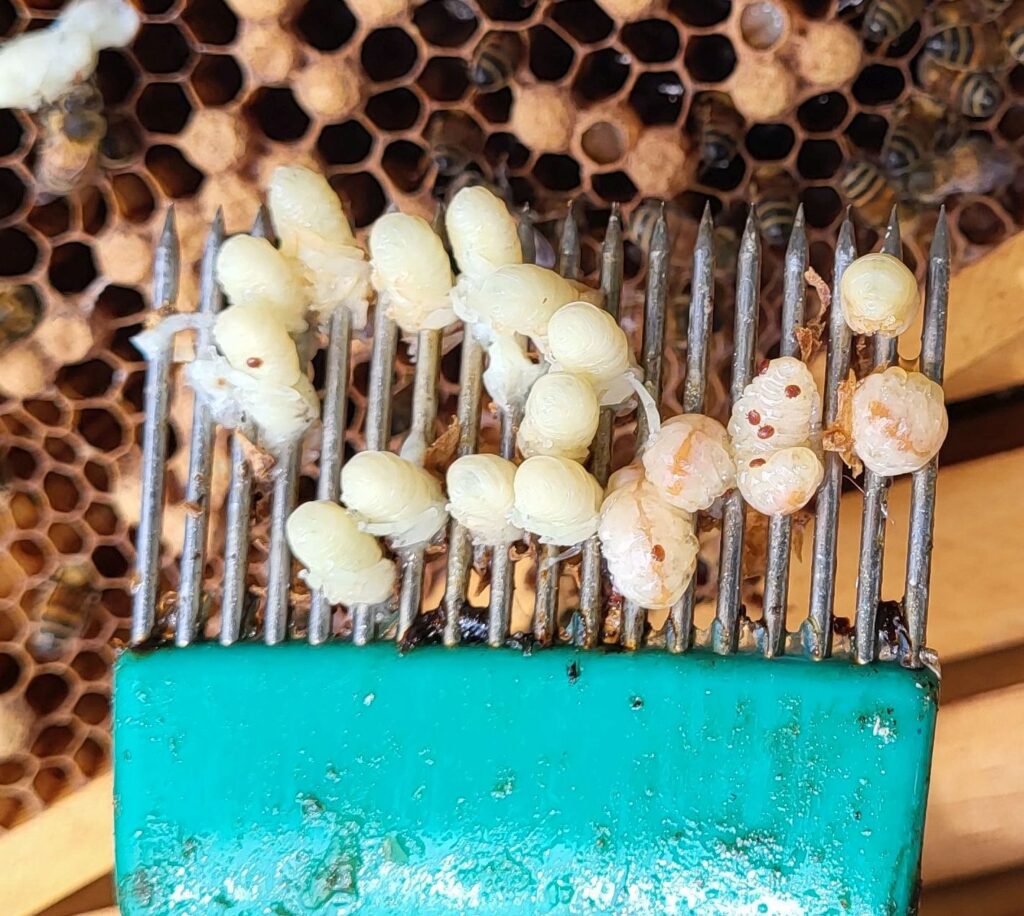
The Effectiveness of Reusing Apistan Strips for Varroa Mite Control – John Caldeira, Fiji, February 2023
ABSTRACT
Chemical control of varroa infestations in honeybee colonies can be a burdensome expense to beekeepers.
Past research has indicated that most of the active chemical in Apistan, tau- fluvalinate, remains in the strip after a normal 6-8 week treatment period.
This experiment sought to measure the effectiveness of using Apistan strips to treat a second bee colony.
Reusing each strip to treat a second bee colony would effectively halve the cost of treating with Apistan.
In this experiment, Apistan strips that had been previously used per label instructions for a 6-week treatment were applied a second time in four other beehives that were heavily infested with varroa.
The used Apistan strips were 98%+ effective in killing varroa mites. This suggests an opportunity for beekeepers to save substantial expense by reusing Apistan strips.
OBJECTIVE
The objective of this experiment was to measure the effectiveness of re-using Apistan strips.
After using Apistan as directed for 6-8 weeks in one hive, this experiment sought to confirm how effective the Apistan strips are if used in a second hive for another 6-8 weeks treatment period.
This is important to beekeepers who need to save money, as Apistan is relatively costly and the Apistan packaging does not report the effectiveness of reusing Apistan strips, instructing to dispose of the used strips.
BACKGROUND
Earlier research suggests that Apistan strips may be effective if reused to treat more than one bee colony.
Researchers in Italy reported that the amount of active miticide in Apistan, tau- fluvalinate, does not decline much during the normal treatment period:
“The fluvalinate content in plastic strips [Apistan] remained almost constant during the 10 weeks of treatment. No significant differences between initial (11.5 + 0.6%) and terminal (10.7 + 0.3%) fluvalinate concentration were observed, indicating that removal by the bees was very small and the active ingredient strip dosage more than sufficient to control the varroosis.”
Fluvalinate content of Apistan strips during treatment and efficacy in colonies containing sealed worker brood, Cabras, Floris, et. al, 1997, Apidogie 28, 91-96. (Ref 1)
Bruce Clow, manager of Ceracell Beekeeping Supplies, New Zealand, explained that “a ‘polymer matrix’ [the plastic strip] holds the active ingredient in little cells. It is sort of like a sponge full of water.
Each cell contains just the right dose to kill a mite. When a bee bumps into the strip one dose from an outside cell is delivered to the bee.
The polymer matrix actually holds the active ingredient really tightly so in order to refill that now empty cell on the outside of the strip, they needed a very large amount of the active ingredient in the inner parts of the matrix so it would move out.
They called it a chemical pump. These physical and chemical properties are critical to ensure a consistent lethal dose is delivered for the whole 8 week period. When the 8 weeks are up, and the strip is removed, 99% of the chemical comes out too. It is locked in the polymer matrix!” (Ref 2).
He further explains “Apistan does not evaporate when the packet is opened (the polymer matrix holds the chemical tightly), and the unused strips last perfectly well in the opened packet just clipped shut until they are put in the hive and bees start bumping into them.”

EXPERIMENTAL PLAN
Apiary Location: Volivoli, Rakiraki, Ra, Fiji. Apiary owners Farnaaz Farisha and Dean Tazim.
After using Apistan as directed by label instructions to treat honeybee colonies for varroa for a 6-8 week period, the same Apistan strips were used again in a second colony for a 6-8 week period.
Pre- and post- treatment mite counts will be estimated using soap wash and sticky boards.
At the end of the second use treatment, new Apistan strips and another miticide were placed in the hives and mite drops measured to learn how effective the 2nd use strips were by counting mites that remained alive at the end of the treatment.
January 2, 2023
- Four hives that had not been treated for varroa mites were selected for experimentation. A few quick forking of drone pupae indicated a high mite load.
- Soap washes were performed on two of the hives, and it confirmed high infestation of varroa jacobsoni. A coloured digital pen was used to count mites.
- Fifty -two mites on a half-cup of bees in hive 1. Eighty- eight mites washed from bees from hive 2.
- Two Apistan strips were placed in the brood area of each colony.
- The Apistan strips had been removed from other hives the day prior after six and a half weeks use to kill varroa.
- A sticky board (half) was placed in two of the colonies to measure mite-drop.

January 3, 2023
The sticky boards were removed approximately 24 hours after applying the reused Apistan strips. The mite counts on the sticky boards were observed.
Finding #1: Big mite drops on both sticky boards. Several hundred on each sticky board.
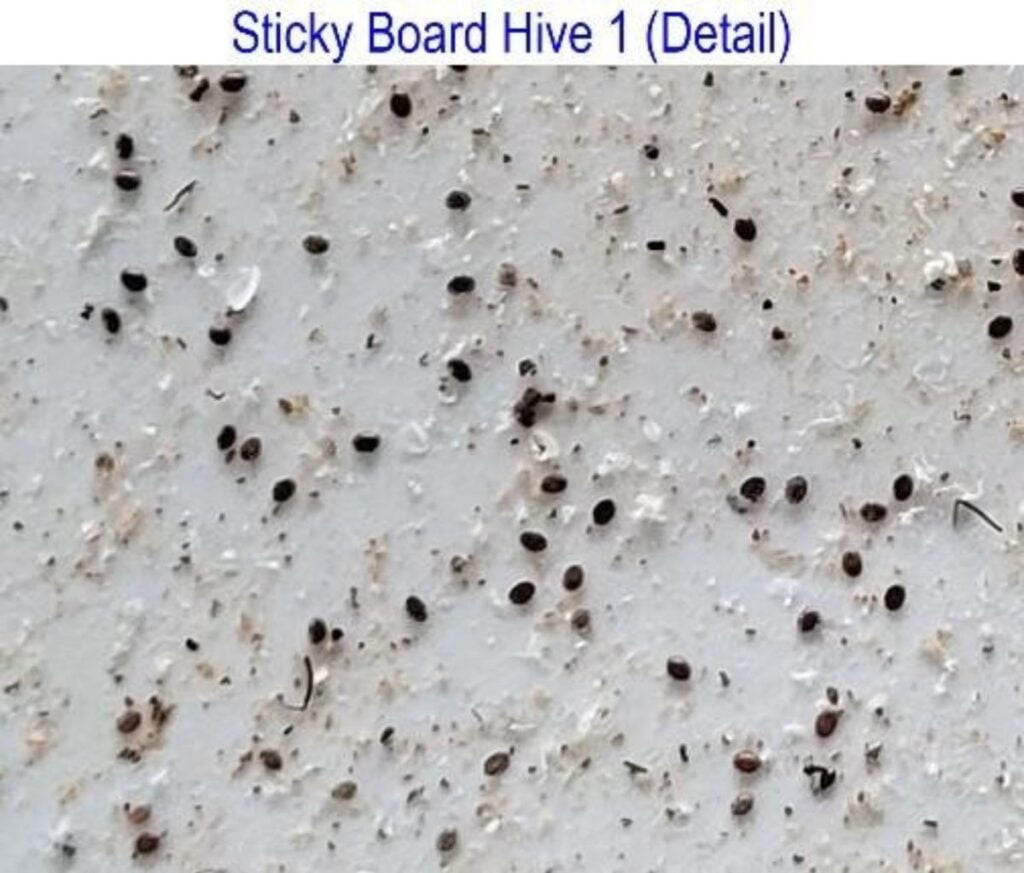
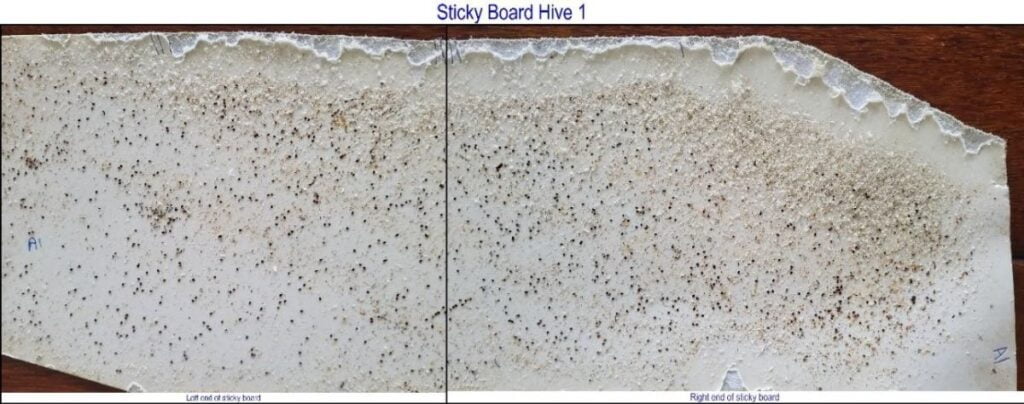
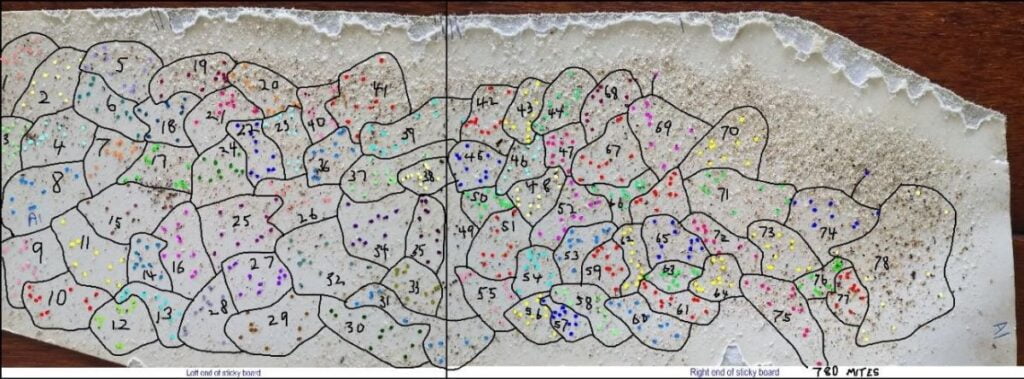
The count on hive #1 was 780 mites dropped onto the sticky board. Hive #2 exceeded 490 mites on the sticky board.
February 16, 2023
Six and a half weeks have passed since the 2nd use Apistan was placed in the 4 Volivoli hives. To measure effectiveness of the treatment, two approaches are used:
1. Soap wash on all 4 colonies.
2. New Apistan strips and also Amitraz (3 ml on paper towels) were placed in all four hives with sticky boards to measure mite kills that the reused Apistan might not have killed.
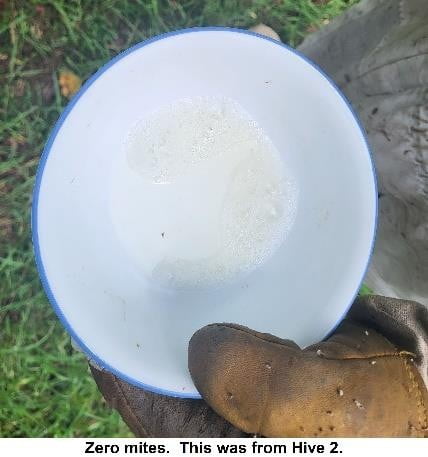
February 17, 2023
The sticky boards were removed from the hives for counting of mites.
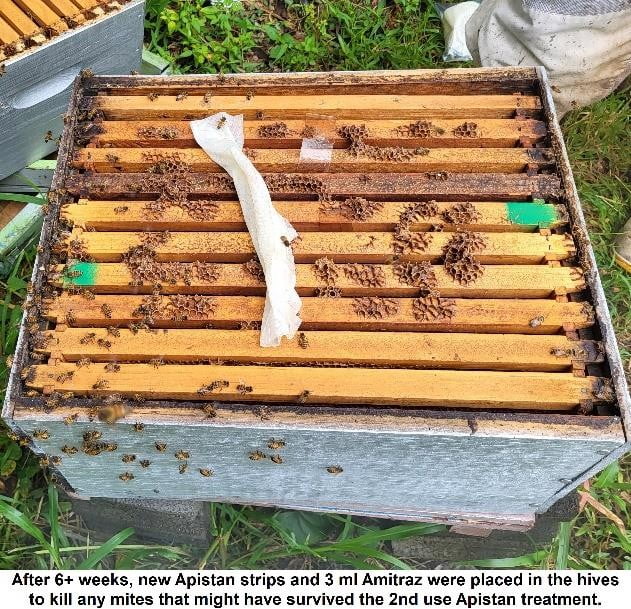
RESULTS
Soap washes on all four hives at end of treatment did not result in any mite drops. Zero in all four soap washes. This indicates a likely 98%+ effectiveness.
Sticky boards in all four hives yielded the results shown in this table, also indicating 98%+ effectiveness:
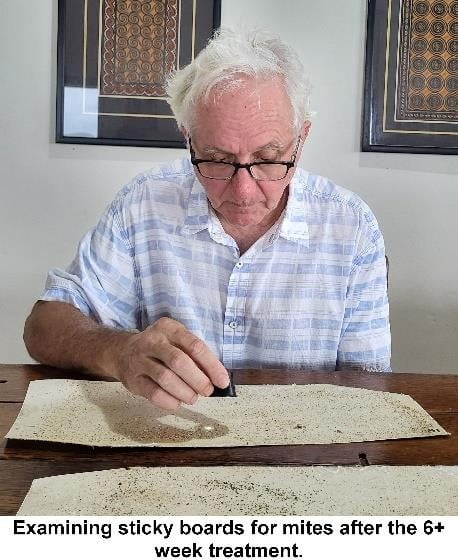
| 2nd Use Apistan Test Results (number of mites) | ||||
| Hive1 | Hive2 | Hive3 | Hive4 | |
| Soap wash mite falls (half-cup of bees) | ||||
Pre-treatment soap wash (Jan 2) | 52 | 88 | Only drone forking (showed mites) | Only drone forking (showed mites) |
| Post-treatment soap wash (Feb 16) | 0 | 0 | 0 | 0 |
| Sticky board mite falls (1/2 board diagonally in hive) | ||||
| Start of experiment: January 3 (24 hours after applying 2nd use Apistan) | 780 | 490 | Not tested | Not tested |
| End of 2nd use experiment: February 17 (24 hours after placing NEW Apistan and 3 ml Amitraz into hives) | 1 | 0 | 1 | 4 |
CONCLUSION
In this experiment, Apistan remained highly effective for controlling varroa when used a second time, using package instructions for a 6+ week treatment.
For beekeepers who have been discarding their Apistan strips after first use, it suggests they can halve the cost of treatment by using the strips a second time.
The retail package instructions for Apistan sold in Fiji do not address the effectiveness of reused strips, advising only to dispose of them.
Best practice is to treat all hives in an apiary against varroa at the same time, to slow the re- introduction of mites from drifting bees.
Thus a second use of Apistan is best applied by treating one apiary entirely, then using the strips for 2nd use in a second apiary.
REFERENCES
- Fluvalinate content of Apistan strips during treatment and efficacy in colonies containing sealed worker brood, Cabras, Floris, et. al, 1997, Apidogie 28, 91-96.
- The Truth About Apistan, Bruce Clow, Mar 2019 https://www.ceracell.co.nz/articles/the-truth-about-apistan/ (accessed 16 Feb 2022)
This experiment was conducted in Fiji in February 2023 by John Caldeira with assistance by Ziyaad Hussein and cooperation of Farnaaz Farisha.
